With Kansas in its fifth straight decade of economic stagnation, Commerce Secretary David Toland’s Framework for Growth plan looks to propose the same things tried in the past rather than address the root causes of stagnation.
There’s an alphabet soup of subsidy programs in the Framework for Growth that are proven failures.
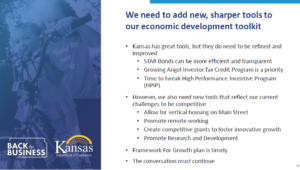
The ubiquitous nod to workforce development in the plan ignores the elephant in the room – dismal student achievement that is getting worse.
Kansas has more 10th-graders below grade level in Math than are on track for college and career, and that dismal performance is borne out in ACT scores. Only 23% of Kansas graduates who took the ACT in 2020 were considered college-ready in English, Reading, Math, and Science.
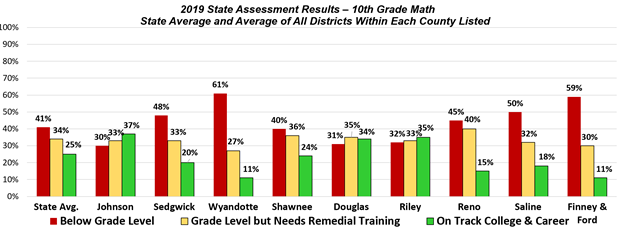
The affordable housing proposal in the Framework for Growth is another if-we-build-it-they-will-come scheme that will only benefit the builders.
Toland’s own local experience should have taught him that his plan won’t work. Before joining Governor Kelly’s cabinet in 2019, Toland spent ten years in economic development as Thrive Allen County president. As previously reported by the Sentinel, his tenure was marked by a 14% drop in jobs in the county, population decline, and rapidly rising property tax.
Businesses that don’t receive taxpayer subsidies complain that so-called incentive programs put them at a competitive disadvantage with those that receive the subsidies, and our reporting found a lot of those complaints in Allen County.
The Framework for Growth plan papers over reality like the con artists posing as weavers in The Emperor’s New Clothes. Toland’s recent presentation to the Senate Commerce Committee identifies jobs supposedly created or saved by subsidy programs, but it turns a blind eye to the reality of decades of sub-standard job growth. And that’s pretty common; subsidy supporters want to take credit for the jobs they claim to be bringing through the front door but ignore the ones going out the back door.
Contrary to claims of plentiful job creation, academic studies find little value in subsidy programs. One of the subsidies promoted by Toland’s Commerce Department is the Promoting Employment Across Kansas (PEAK) program. Dr. Nathan Jensen, then with Washington University at St. Louis, studied PEAK and concluded that companies receiving PEAK incentives were no more likely to add jobs than companies that did not receive the subsidy.
Last year, Dr. Arthur Hall completed an analysis of several STAR bond projects for Kansas Policy Institute (the Sentinel’s owner) that found they mostly rearranged economic activity within the community rather than create new, incremental activity.
Most recently, a Legislative Post Audit report found the recipients of another of the Framework for Growth subsidy deals – the Angel Investor Tax Credit – produced no substantial performance difference between companies that received the tax credit.
Consequences of economic stagnation
Kansas has been trailing the nation in economic activity (GDP) and job growth since the early 1980s, and the gaps are getting wider.
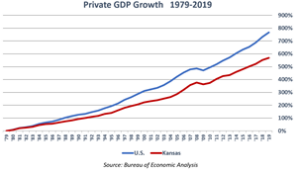
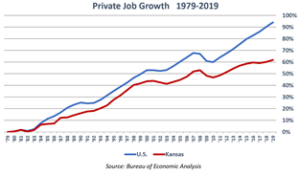
To put the gap between Kansas and the nation in perspective, Kansas would have had an additional 313,000 jobs in 2019 if private jobs had grown at the national average since 1979. Had private-sector GDP growth matched the national average, Kansas would have had an additional $22.4 billion in economic activity.
So you must be wondering why, given the facts, do local chambers and state commerce secretaries persist with subsidy schemes instead of attacking the root causes of economic stagnation.
States that spend less, tax less…and grow more
Taxes are not the only thing that impacts economic competitiveness, but they are a major factor. Data from the Bureau of Economic Analysis show the states without an income tax increased private-sector jobs by 49% between 1998 and 2019, while the other states grew by just 24.6%. The ten states with the lowest combined state and local tax burden also had superior job gains than the ten highest-burden states (42.4% vs. 27%).
The same is true of private-sector GDP growth. The states without an income tax grew by 161% between 1998 and 2018 in current dollars vs. 122% for the other states. The ten lowest-burden states outperformed the ten highest-burden states, 154% to 130%.
The amount that states choose to spend providing services is the only thing that determines how much they must tax. Every state provides the same basket of services, but in 2018, the states that tax income spent 55% more per resident than the states without an income tax; Kansas spent 40% more than the no-income-tax states.
The Kansas Chamber’s recent statewide business poll also shows the importance of reducing taxes. The top five issues identified as most important to profitability are lower taxes on business, managing healthcare costs, decreasing regulations and mandates, limiting government growth, and reducing energy costs.
Toland’s big push for affordable housing – notably, high rises on Main Street in small towns – isn’t mentioned. It is worth pointing out the economic incentives appear on the Chamber’s list, but they are #6 on the list.
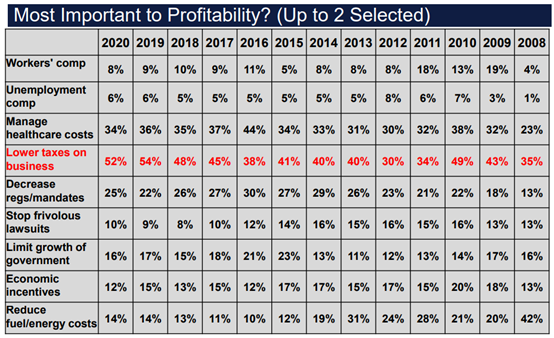
None of the top five crucial issues identified by business owners are included in Toland’s economic development plan; neither are any of the Kansas Chamber’s recommendations to foster job and economic growth.
Instead of giving businesses what they say they need, state and local governments, along with local chambers of commerce, insist on giving companies what they want them to have – subsidies.
Giving businesses what they need to flourish is simple – get out of their way and spend less so you can tax less – but that requires state and local government to change focus, and many repel from change as two magnets with the same pole.
The same is true of improving student achievement. Giving Kids a Fighting Chance, KPI’s documentary of Florida going from one of the worst in the nation to one of the best (while spending a lot less money) shows tremendous opportunity for Kansas kids. But implementing Florida’s cocktail of choice, transparency, and accountability requires education officials to put students’ needs ahead of institutional priorities, and they fight it every step of the way.
Unfortunately, like others in past administrations, Toland’s Commerce Department seems hellbent on attempting to disprove Einstein’s definition of insanity. The Framework for Growth would be more appropriately named the Framework for Deja Vu All Other Again.

